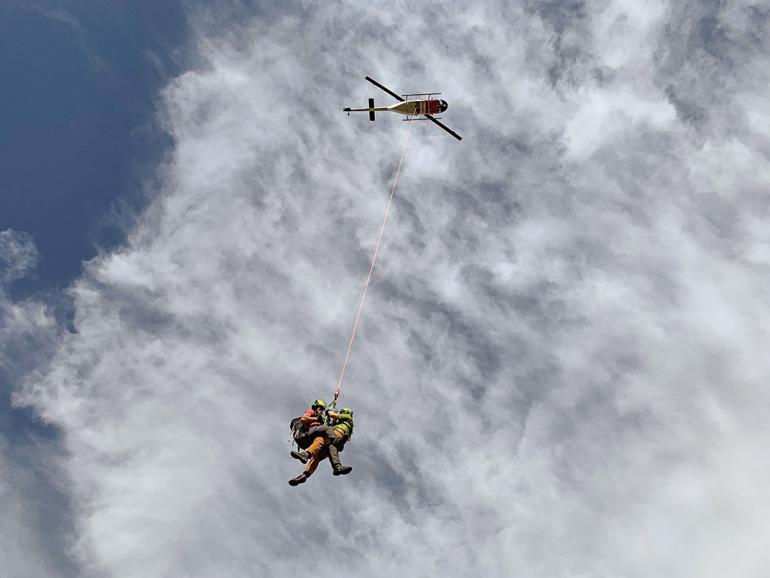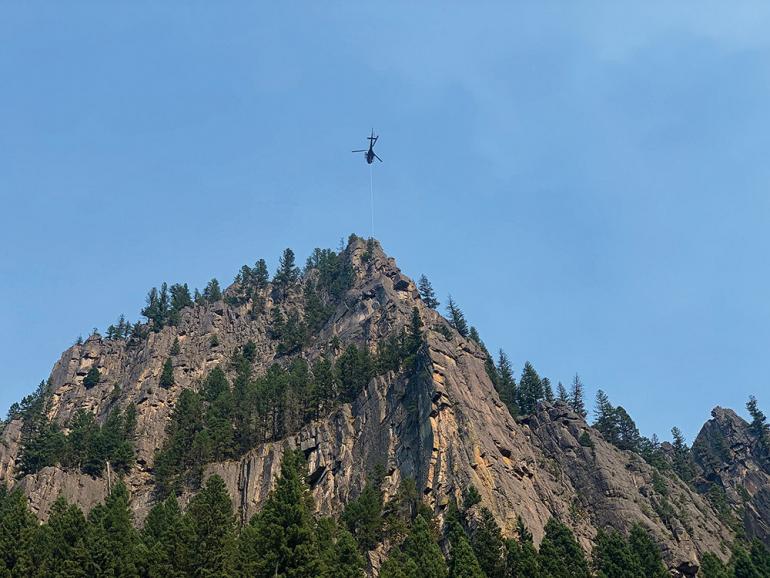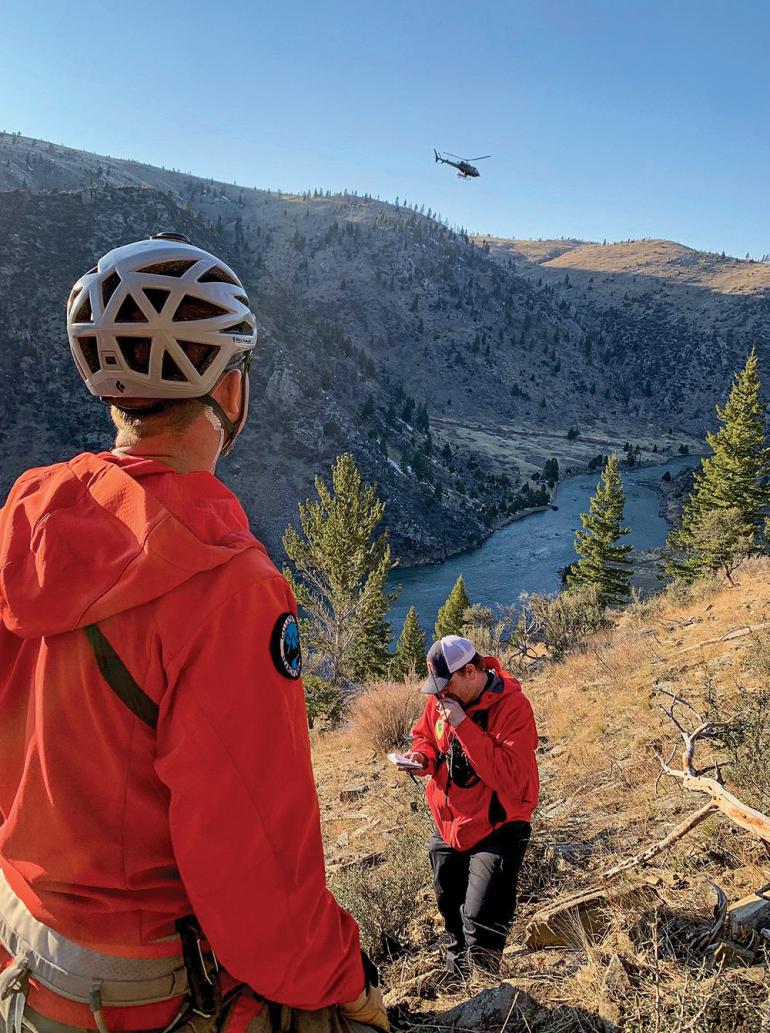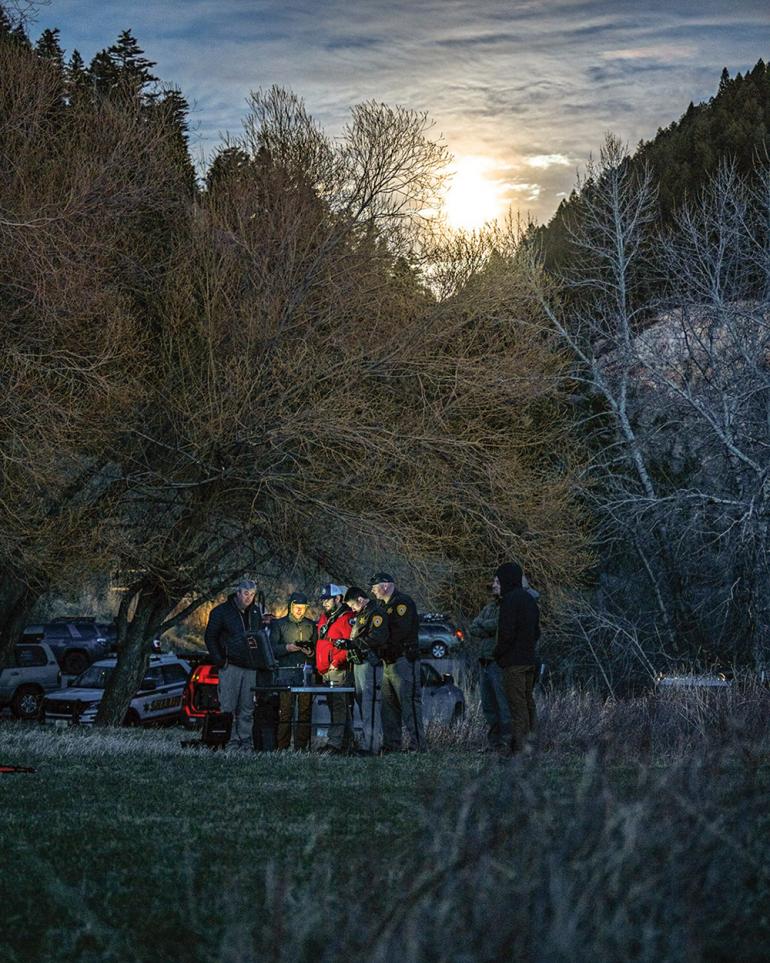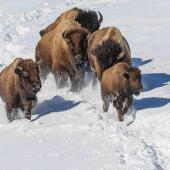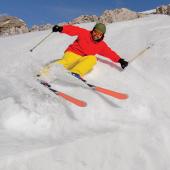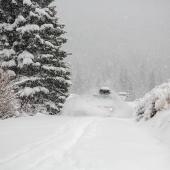Search & Rescue: Last Call
Editor's note: This page comprises several segments of a large feature on the Gallatin County Search and Rescue program. For the other segments, click here.
Got in over your head in the backcountry? Considering a call for help? Here’s what you need to know about skills, safety, and Search & Rescue, when you’re down but not out.
In the outdoors, no matter how diligently we prepare, no matter how much experience we have, things don’t always go as expected. On the bright side, that’s what makes a good adventure: dealing with challenges, overcoming obstacles, and learning lessons along the way. But we also need to come home safely, which is where a solid plan comes in—not only for your proposed route and activity, but also for how to respond if things go awry.
An old adage says it best: hope for the best, but prepare for the worst. And in some cases, the worst may include making a call for help. It’s important to know how and when to call, and to familiarize yourself with the resources that may—or may not—be available. So read on for stories, tips, facts, and figures, starting with a message from the Gallatin County Sheriff Search and Rescue Commander.
The men and women of Gallatin County Sheriff Search and Rescue are a diverse group of volunteers brought together by their love of the outdoors and a common interest in helping their fellow citizens. They volunteer hundreds of hours each year to sharpen their skills, enabling them to be a more effective team. We are honored to be able to provide this resource and offer peace of mind to all outdoor enthusiasts. —Captain Scott Secor
Hubris, Hoplessness, and a Helicopter Ride
Cocky ambitions lead to a humbling experience in Hyalite
by Nick Cusick
Nobody plans to end the day hike with a helicopter rescue. But when you’re a group of sixteen-year-olds, you don’t plan on anything. On a stormy day in August, that was our situation: Ethan, Aaron, and I sitting above a cliff in the rain, waiting to get rescued. We had no warm clothes, no lighter, and no clue.
The three of us started hiking up to Mount Blackmore well before sunrise. We were new to the “alpine start” and lost track of how much ground we were covering. We were focused on chasing the small bits of trail that our headlamps lit up. After a few hours, we summited the peak as the sun was rising. The day had just begun, and I didn’t want to turn around. I proposed to my friends that we should leave the trail, follow the ridge south, and drop into the Twin Falls basin to check out a new spot. There was some hesitancy, but eventually, we were all following the ridge toward Elephant Mountain.
As we pushed past Elephant, the ridge became increasingly technical. Ethan wasn’t having it. While navigating the crumbly conglomerate, he mentioned that if things went south, we could call Gallatin County Search and Rescue (SAR) to help us. I interpreted this as an attack on my ego and told him he was being ridiculous. Aaron didn’t side with either of us. I started leading us faster down the ridge and into the basin.
It was around noon when we made it off the mountainside and into the lush cirque. As the scary terrain diminished, our anxieties did, too. We spent a long time loafing around Palace Lake. There were fresh springs gushing up from the ground, flowers everywhere, and nobody else around. I gazed up at the vertical north face of Arden Peak farther up the drainage and felt invincible. All we had to do was follow the outlet of the lake back to the main fork of Hyalite Creek. The contour lines on our topo map were a little close together next to Twin Falls, but I told everyone it would be fine. This route would be a whole lot easier than hiking back up the steep, rocky ridge we came down.
Peering over the 200-foot waterfall, I knew we were screwed. Apparently I’d assumed that every waterfall in Hyalite must have some kind of path around it. There was some climbing tackle tied around a tree left by ice climbers, but that was the only sign that other people had been there before—and they clearly had ropes. I wasn’t ready to give up, though. We romped around in all directions, but couldn’t find a route. At this point, Ethan wasn’t having it at all. Aaron looked destroyed. Dark clouds converged above us. With a nasty storm brewing, and a full retreat back to Blackmore out of the question, I knew it was time to seek outside assistance. We began hiking up a steep gully on the north face of Palace Butte Mountain in search of cell reception.
We reached a perch hanging high above the main drainage of Hyalite and Ethan’s phone got a signal. I could feel the moisture from the clouds fill the air. Luckily, Ethan knew a guy named Todd who worked with SAR and called him. He asked Todd if there was a way out from where we were. The answer was no. He told us to stay put and that help was on the way. But I had no interest in hanging out in that notch in a storm. As the rain started, I convinced my friends to beeline it back down the gully to a more comfortable spot.
The dirt was getting slick, so rather than staying in the trees on the side, I kept to the center of the gully. Aaron started climbing down after me and slipped. Well above me, he began barreling down the mountain toward me. I had no option but to brace for impact. When his body hit mine it was the most gripped I’ve been in my life. I dug in my heels and clawed at the dirt. We slid a little bit together but eventually came to a stop. Picking ourselves up, we both took a deep breath and looked down the rest of the gully. It was a close call, but could’ve been much worse. We traversed into the trees and Ethan followed. After slowly descending, clinging from tree to tree, we eventually made it back to flat ground.
While waiting in the pouring rain, I started to laugh. We had made so many poor decisions and laughter was how I filled the nervous silence. It was probably inappropriate, especially since I was the leader of our dumb expedition. Not to mention our parents were going to be livid. Aaron joined in but Ethan was mostly quiet. I don’t blame him. There was still plenty of uncertainty. We weren’t sure in what form our rescue would arrive, but it was soon made clear by the whoosh of helicopter blades.
Ethan and I loaded up first; the helicopter would make a second trip to get Aaron. I will always remember the powerful feelings of humility and gratitude I felt as the pilot launched us into the sky. As we flew out, the helicopter made a hard bank to the left and my face smushed up against the window. I got a bird’s eye view of the basin floor as it dropped hundreds of vertical feet into the main Hyalite drainage. I had dragged us in way over our heads and SAR pulled us out. I cannot thank them enough. And I cannot forget how the mountains humbled me that day, and taught me an important lesson: always prepare for the worst.
Wrong Turn Righted
A day's work for Gallatin County SAR
by Austin Greydanus
BEEP-BEEP-BEEP. It was 10am on Sunday and the sound of my pager meant I was needed. I stopped what I was doing, read the pager to see what kind of call this would be, and turned on my radios to wait for an update. A 911 dispatcher told a deputy that a father and two children were lost on Mount Ellis. The father could not give a last known location or a landmark for where the family might be. I radioed to the posse coordinator that I could respond and was enroute to the Search and Rescue (SAR) building. Once there, I fired up a truck with an ATV and an Orion (a wheeled cart to carry injured patients), then radioed the SAR coordinator that I was on my way to the trailhead. A few other volunteers had responded, grabbing the other truck and equipment and heading out behind me.
As volunteers with Gallatin County Sheriff SAR, we see a variety of calls, and our crew must be ready for anything—especially a huge area to search and no known landmarks to key in on. Obviously, the more searchers, the better, but each volunteer is equipped with enough food, water, and gear to survive on one’s own for 24 hours. Once we arrive on-scene, we check in with the posse coordinator to be assigned to a three- or four-person search group. Then we brief.
This day, we splayed open a map on the truck’s hood in the sunshine. Because we didn’t have coordinates or a definitive location of where the family was, we attempted to narrow down the possibilities, discussing terrain, trails, and roads. Then we created search areas for each group. I ended up operating an ATV with the Orion on the main trail along with several other ATVs.
My rescue team headed up the trail, stopping at the first switchback. We off-loaded, hiked down the ridge, and attempted to locate the missing hikers with binoculars. We yelled their names, but were met with silence. The team decided to hike down a little further to get another vantage, but unfortunately this produced the same result.
Now, it’s called “searching” for a reason. It’s disheartening not to see the lost party on the hillside or hear a response right away, but it’s quite common, and as a responder, it’s a part of the gig. We’ll keep searching until we have a rescue or recovery for all of our subjects.
We continued up the trail. By this time, afternoon clouds had diminished our visibility. It started to drizzle. None of the other search groups were having any success, either. We continued the same technique of hiking away from the ATVs and calling out, waiting for a response from the missing family, but got nothing.
|
|
At about 3:30, one of the search parties radioed that they’d made contact. The family had wandered off at a switchback and hiked down the hillside, but soon got turned around and had no idea where they were. Dad was hiking with two little kids in an unfamiliar area without maps or supplies. As soon as the family knew they were lost, they stayed put—something that we teach—and had been spotted from a two-track through binoculars.
My group of ATVs backtracked and took a different road to get to the recovery site. By that time, the group of rescuers had gotten the family up onto the road. As my group met up with the other search crew, we made sure that the family was okay. Besides being wet and hungry, everyone was in good spirits. We provided snacks, water, and a dry blanket for the Orion ride back to the Mount Ellis trailhead, where an American Medical Response team checked them out. They were fine—another successful ending for a search-and-rescue mission.
If you’re ever in need of SAR, please call earlier rather than later. Always attempt to have a fully charged cell phone; place it in airplane mode to save battery. Call 911 when you need assistance. If you don’t have service, attempt to send a text message to 911 or a friend, requesting SAR’s help. Try to know your location, state the problem, and what you need help with. Always bring along a whistle, a headlamp (the light aids navigation in darkness but also works as a signal to rescuers), firestarter, and dry clothes. Have a paper map illustrating terrain, landmarks, creeks (water sources & crossings), and shelter locations. Pack like you’ll be staying overnight. Tell someone where you’re going and when you’re expected back. And as always, use the buddy system.
Austin Greydanus started volunteering with SAR in 2008. He was the Sheriff’s Posse Secretary/Treasurer for a couple years, but currently fills the role as Posse Coordinator, as well as working full-time as a detention officer for the Gallatin County Sheriff’s Office.


